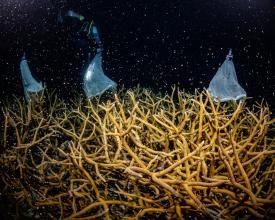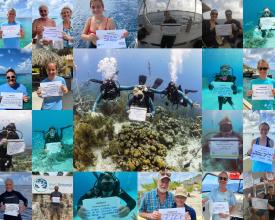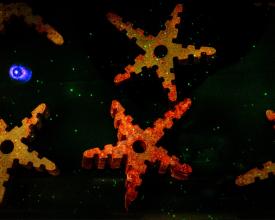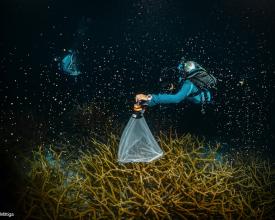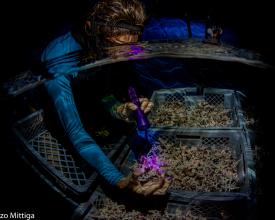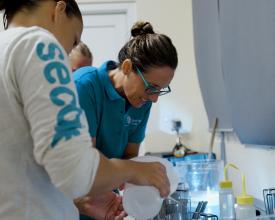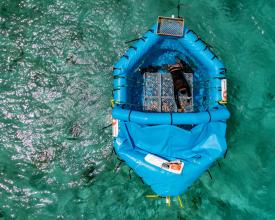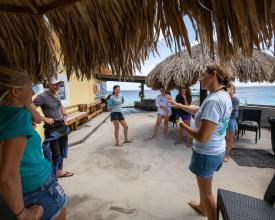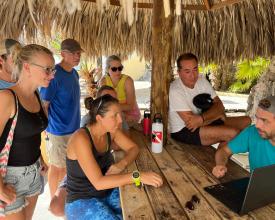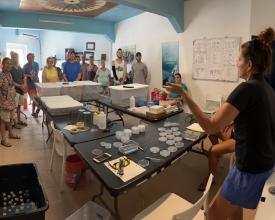Propagation larvaire pour aider au rétablissement et à la résilience des populations coralliennes de Bonaire face aux nouvelles maladies et aux changements environnementaux.

Face au changement climatique et à la pression croissante exercée sur nos récifs, il est primordial de trouver des moyens d'accroître la force des populations de coraux et d'aider à leur rétablissement. Bien que certains récifs de Bonaire présentent encore de belles parcelles de corail, certaines zones montrent des signes visibles de dégradation. C'est pourquoi il est important d'élever les larves des principales espèces de coraux, car la recombinaison génétique pourrait donner naissance à de nouvelles souches mieux adaptées pour faire face à l'évolution des conditions environnementales. Reef Renewal Bonaire (RRFB) a contribué à la reproduction sexuelle de plusieurs espèces de coraux en propageant des milliers de colons coralliens génétiquement uniques, qui ont été transplantés sur les récifs ou ajoutés au stock génétique des pépinières de RRFB. Le projet a été possible grâce à l'établissement de partenariats clés et à l'implication des opérateurs de plongée et des volontaires locaux, qui ont eu l'occasion d'expérimenter directement le processus de propagation du corail et son rôle crucial dans la préservation des récifs.
Contexte
Défis à relever
Les récifs coralliens des Caraïbes sont confrontés à des changements rapides de l'écosystème dus à des maladies omniprésentes, à des phénomènes de blanchiment du corail et à des menaces locales telles que la surpêche, la pollution et le développement côtier. Même Bonaire, dont les récifs abritent encore d'importantes populations d'espèces coralliennes, n'est pas à l'abri des tendances régionales. Les colonies saines peuvent être trop éloignées les unes des autres pour se reproduire avec succès par le seul biais de la reproduction sexuelle, ce qui limite la formation de nouvelles souches génétiques. Il est essentiel de gérer les facteurs de stress locaux tout en repeuplant les récifs cibles avec des populations coralliennes résilientes et génétiquement diversifiées afin d'empêcher leur disparition irréversible. Il est important d'intégrer le plan de gestion du parc marin à une stratégie de restauration active qui facilite la reproduction sexuelle des coraux et favorise la recombinaison génétique afin de donner à cette espèce une meilleure chance de survivre aux maladies coralliennes qui se propagent rapidement et aux conditions environnementales variables.
Emplacement
Traiter
Résumé du processus
Le partage des connaissances, le soutien mutuel et l'engagement de la communauté locale ont renforcé Reef Renewal Bonaire en tant qu'organisation et augmenté sa capacité à tester et à appliquer de nouvelles méthodes et technologies, et ont permis à RRFB de continuer à intensifier les efforts de restauration à Bonaire afin d'en maximiser l'impact.À une époque où il est essentiel de mettre un terme à la dégradation des récifs, il est primordial de ne pas perdre de temps à réinventer la roue et d'apprendre au contraire à travailler ensemble de manière constructive.
Blocs de construction
Mise en œuvre et perfectionnement des technologies et des méthodes de propagation des coraux
La propagation larvaire est une méthode de restauration qui assiste la reproduction sexuelle des coraux afin d'augmenter leur diversité génétique. Cette technique peut être utilisée avec de nombreuses espèces et morphologies de coraux et, en raison de la production importante de gamètes pendant la ponte, elle permet d'augmenter le nombre de coraux transplantés sur le récif. Le RRFB utilise des technologies innovantes pour réduire le temps de travail et de manipulation et augmenter le taux de survie des larves de corail à grande échelle. Après avoir été fécondés, les embryons récemment formés sont versés dans des bassins flottants (CRIB, Coral rearing in-situ Basin) conçus par SECORE Int. où l'installation des larves est facilitée sur des substrats spécialement conçus, qui sont ensuite transplantés sur le récif.
Facteurs favorables
-
La présence de colonies de coraux reproducteurs sains à Bonaire fournit des gamètes pour lancer la propagation des larves.
-
L'établissement d'un partenariat solide avec SECORE International, avec une vision commune de la restauration des récifs coralliens.
-
Le soutien de la communauté locale des plongeurs.
-
L'implication d'une équipe solide de personnes motivées et engagées.
-
Le soutien du gouvernement local et de l'organisation non gouvernementale STINAPA, permettant aux activités de restauration de se dérouler dans les limites du parc marin national de Bonaire.
Leçon apprise
-
Commencer à mettre en œuvre des techniques à petite échelle afin de tenir compte des différentes conditions environnementales locales et de trouver les lieux d'application les plus appropriés.
-
Mettre en place les premiers essais en utilisant des espèces de coraux prévisibles et "faciles à travailler".
-
Adapter les techniques de propagation larvaire aux conditions locales, aux ressources disponibles et aux priorités.
Des partenariats clés pour partager l'expertise et les ressources
En juin 2019, RRFB a lancé le premier projet de propagation larvaire à Bonaire en collaboration avec SECORE International. L'objectif de ce partenariat est d'établir une coopération technique dans laquelle RRFB fournit les connaissances locales, la main-d'œuvre, la logistique sur le terrain et une installation, et partage tous les résultats des essais sur le terrain, les données de suivi et les commentaires qualitatifs sur les méthodologies et les technologies fournies par SECORE Int. En retour, SECORE Int. fournit des techniques, des méthodologies, de l'expertise et des sessions de formation sur la propagation des larves. Les connaissances de ce partenariat ont été cruciales pour la mise en œuvre réussie des techniques de propagation des larves à Bonaire. En partageant constamment les résultats et les leçons apprises, la technique a été améliorée, ce qui a conduit à un plus grand succès et à une plus grande évolutivité pour la reproduction future du projet.
Facteurs favorables
-
L'existence d'un réseau mondial bien développé et efficace de scientifiques et de praticiens désireux de partager leurs connaissances de manière constructive.
-
Un partenariat formalisé avec des rôles et des responsabilités bien définis.
-
La possibilité de programmer régulièrement des sessions de formation virtuelles et en personne et l'engagement à le faire.
-
Une vision et des objectifs communs aux partenaires.
Leçon apprise
-
Importance de prévoir des réunions régulières avec les partenaires avant et après chaque étape importante de la mise en œuvre de la technique afin de formaliser les résultats, le retour d'information et les enseignements tirés.
Participation de la communauté et sensibilisation
Impliquer les gens directement dans l'effort de restauration des récifs et faire activement partie de la solution est crucial pour son succès global. Avec l'aide des opérateurs de plongée locaux, Reef Renewal Bonaire forme des volontaires qui participent côte à côte avec le personnel dans les activités quotidiennes sur le terrain. Les plongeurs formés sont essentiels pour partager la vision de RRFB avec la communauté au sens large et deviennent des ambassadeurs naturels pour la préservation et la restauration des récifs.
Des programmes éducatifs et des expériences sur mesure sont organisés pour les écoles, les groupes de jeunes, les entreprises locales et les autorités, afin de les impliquer à différents niveaux des efforts de restauration, tout en leur permettant de voir directement les résultats du projet.
De plus, situés dans des eaux peu profondes, les nurseries et les sites d'implantation sont facilement accessibles aux plongeurs, aux amateurs de plongée avec tuba et aux explorateurs de surface, devenant ainsi une attraction non seulement pour les visiteurs des îles, mais aussi pour les groupes communautaires locaux.
Facteurs favorables
-
Une communauté qui reconnaît la valeur des récifs coralliens et veille à leur préservation.
-
Les opérateurs de plongée sont prêts à travailler ensemble pour une cause commune, en mettant de côté les aspects concurrentiels de l'activité.
-
Un soutien fort aux opérateurs de plongée locaux et à l'ensemble de la communauté de plongée locale (par exemple, en fournissant des bouteilles de plongée aux volontaires).
Leçon apprise
-
Impliquer les parties prenantes bien à l'avance et évaluer méthodiquement leur implication, leur participation et leur satisfaction.
-
Trouvez des moyens de maintenir la motivation et l'engagement des bénévoles.
-
Considérez que la coordination des volontaires demande du temps et de la patience.
Impacts
- Des protocoles de propagation et d'élevage des larves ont été mis en œuvre et des centaines de milliers de larves de coraux de différentes espèces ont été élevées avec succès en laboratoire et dans des bassins flottants in situ.
- Environ 1 250 substrats céramiques contenant des colons coralliens génétiquement uniques ont été transplantés sur une zone de récif dégradée de 1 200 m2. Le surplus de larves coralliennes produites a été relâché dans l'océan pour s'installer naturellement sur les récifs voisins, étendant ainsi les bénéfices du projet au-delà de la zone cible.
- 24 nouvelles souches de deux espèces de coraux ont été introduites dans le stock génétique actuel présent dans le système de reproduction in situ de Bonaire. Ces jeunes coraux seront utilisés comme géniteurs pour propager des milliers de coraux par fragmentation chaque année.
- Les données sur le frai observées à Bonaire ont été partagées dans la région afin d'affiner les prévisions de frai pour les Caraïbes du Sud.
- Deux partenariats importants ont été officialisés, ce qui a permis de renforcer la coopération technique et de développer les capacités pour les projets futurs.
- La visibilité locale et internationale de la technique de propagation larvaire en tant que composante essentielle du projet de restauration corallienne à Bonaire.
- L'implication des opérateurs de plongée et des volontaires locaux dans le projet a permis de s'approprier le projet, de renforcer les capacités et de jeter les bases de la poursuite du projet même après son achèvement.
Bénéficiaires
-
La communauté locale de Bonaire et les visiteurs, qui bénéficient d'un récif plus fort et plus sain, un élément essentiel de l'économie de l'île.
-
STINAPA, l'organisation de gestion du parc marin national de Bonaire
-
Les opérateurs de plongée et les bénévoles locaux participants
-
Les écoles et la jeunesse locale
Objectifs de développement durable
Histoire
La propagation larvaire d'espèces coralliennes à Bonaire ne serait pas possible sans l'implication de nombreuses personnes issues de différentes parties de la communauté (opérateurs de plongée locaux, résidents, partenaires institutionnels, etc.) Chaque personne a sa propre raison de donner de son temps et de son énergie à ce projet, le thème commun étant d'assurer la résilience de l'écosystème récifal de Bonaire.
Nous mettons en lumière les perspectives de deux parties prenantes impliquées dans notre programme de propagation des larves - l'une est un opérateur de plongée local et l'autre un résident bénévole :
"En tant qu'opérateur de plongée, il est essentiel de rendre service au récif. Si nous pouvons participer à une activité qui implique des efforts de conservation, de restauration et d'éducation, nous serons les premiers à lever la main et à aller de l'avant. Les efforts de reproduction du corail résument ce à quoi nous aspirons tous : donner un coup de main à notre récif bien-aimé.
Personnellement, le fait d'avoir participé à des plongées de frai dans le passé, le présent et (espérons-le) l'avenir compte comme ma petite contribution à un effort aussi ÉNORME pour préserver le récif que nous aimons. Du repérage des colonies possibles à la collecte des gamètes au filet, le frai est quelque chose qui récompense et justifie mon existence et mon soutien aux efforts de restauration du RRFB à Bonaire !"
-Augusto Montburn, directeur du magasin de plongée
"Ce que j'ai préféré lors des plongées de frai du corail cérébral, c'est de les voir libérer leurs gamètes. C'était magnifique à voir et incroyable d'être impliqué d'une manière ou d'une autre. Le frai du corail est le point de départ de tout - et tout ce que je peux faire pour rendre service à nos magnifiques récifs ici à Bonaire en vaut vraiment la peine !
-Ellen McGraw, bénévole dévouée à Reef Renewal Bonaire
